Car Sputters When Accelerating At Low Rpm? (Below 2500)
Vacuum leak is the most likely cause of car sputtering at low RPM acceleration. This lets more air into the engine and mixes it with fuel poorly. This affects the combustion and makes your car sputter or jerk at low RPM. A bad ignition coil or spark plugs can also cause misfires and engine vibration, and cause your car to sputter. Other causes are bad MAF sensors, fuel filter, dirty throttle body, dirty air filter, or PCV valves.
Cars nowadays should accelerate smoothly, but you might’ve faced a troubling issue of sputtering when trying to gain speed. This jerky acceleration at low RPM occurs due to specific underlying reasons.
Proper acceleration requires a fine balance of fuel mixture and timing. Disruptions to either can cause the engine power to falter when accelerating from lower speeds. In this guide, we will delve into several reasons for which your car might sputter or jerk when accelerating at low RPM.
If you want to get a quick answer, you can also chat with a virtual mechanic for free.
For you all, I’ve created an interactive tool that aids in identifying car troubles. It guides you through easy-to-follow steps. Don’t miss out on checking it.
You can also read my guide on causes of Car won’t accelerate but RPMs go up.
- Vacuum leak most likely causes car to sputter when accelerating at low RPM. It lets in too much air and mixes poorly with fuel, affecting combustion.
- Bad ignition coil or spark plugs can also cause misfires and vibration, making car sputter.
- Other potential causes include dirty air filter, throttle body, fuel filter, MAF sensor, or PCV valve issues.
What is My Personal Experience With Car Shaking During Low RPM Acceleration
My uncle drives an older Nissan Maxima that recently started sputtering badly when accelerating from low speeds. I helped him diagnose the issue by checking the air filter and fuel system components.
We found his MAF sensor was extremely dirty, reducing airflow to the engine. I used a brake cleaner to thoroughly clean the MAF sensor, and his acceleration issues disappeared.
How Does Engine RPM Change With Throttle?
The throttle controls how much air and fuel flows into your engine. When you press down further on the gas pedal, known as increased throttle input, more air enters the combustion chambers.
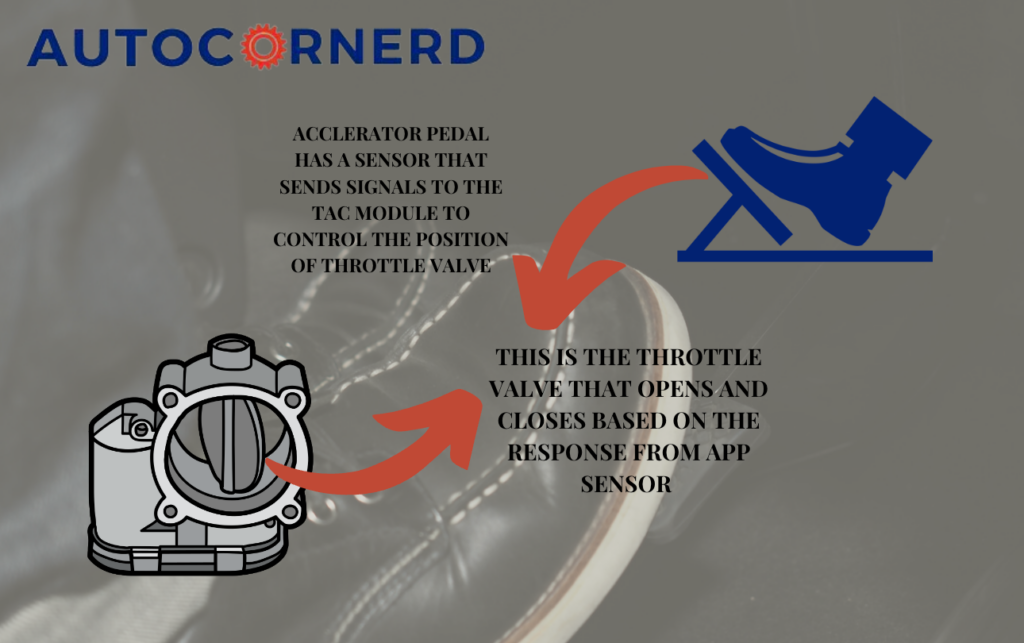
Just like giving a fire more oxygen to burn stronger, this extra airflow allows more fuel to be injected and ignited, generating higher engine power and rotation speed.
At idle, your engine lazily spins at 700-900 RPM, merely sipping air and gas to keep running. Stomp on the throttle and it’s like kicking a hornet’s nest! The engine computer scrambles to open injectors wider, matching more fuel to the boosted airflow. With this bountiful mix, engine RPM rapidly climbs higher as torque and horsepower increase.
It’s important to understand RPM doesn’t build linearly. The rate of acceleration tails off approaching redline due to engineering limits on airflow and combustion.
The RPM curve follows more of an exponential shape, meaning large jumps in the beginning then tapering off as engine speed nears maximum revolutions per minute.
This is because the engine becomes less efficient at higher RPMs, and it requires more energy to maintain each additional RPM.
You may also face issues of RPM fluctuating at constant speed.
What are the Causes Of Car Sputters When Accelerating At Low Rpm
Here are the causes of engine hesitating during low RPM acceleration
1. Dirty Air Filter Leads to Car Stumbling When Accelerating
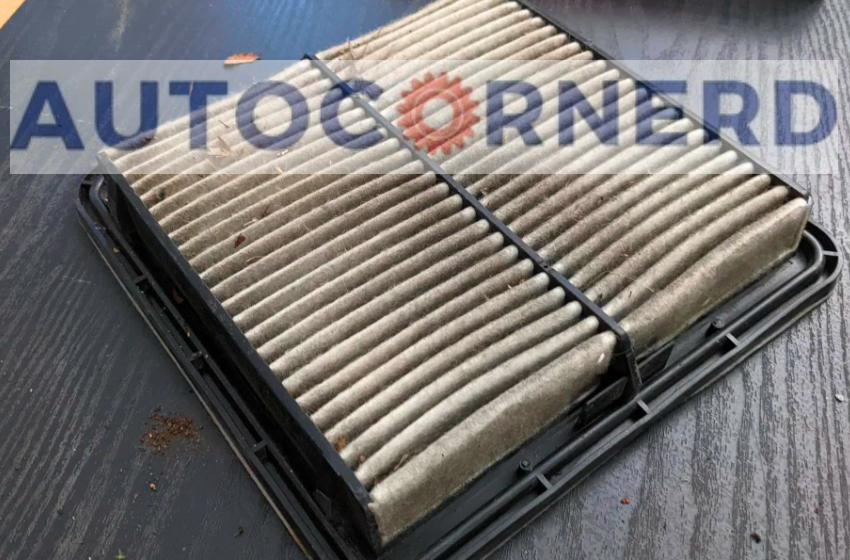
The air filter is your engine’s first defense against dirt and debris. This humble component has an important job – to trap particles so only clean air reaches the engine. When it works right, the results are smooth sailing. But when the air filter gets clogged and dirty, you feel the effects quickly.
A clean air filter allows maximum airflow to the engine. More air means better combustion when the air and fuel mix ignites in the cylinders. The end result is an engine humming with power to push the vehicle forward.
Over time, trapped particles restrict that essential airflow. As the filter chokes, you may notice the engine struggling for breath as it starts picking up speed from acceleration. Without enough air reaching the engine, ignition suffers and performance declines.
The airflow rate is already lower at low RPMs. Add in a blocked filter that further limits intake, and pressure drops even more. The engine can’t pull enough air through the dirty filter to operate smoothly.
How to spot?
An engine air filter sits in the housing on the air intake side. You have to remove the engine cover to see that.
You should check the area below the air filter that sits in the housing. It is usually the intake side where outside air first passes through. So, the dirt drops there after being sucked in.
Determining if your engine air filter needs replacement can be done by checking its color. Ideally, an air filter that’s still in good condition should be white or off-white. However, when it becomes dirty, its color changes to gray or black. In extreme cases of air filter neglect, it may turn brown or dark brown.
If your car is only sputtering when accelerating, make sure to read my guide on that topic as well.
2. Vacuum Leaks Cause Misfires and Car Jerking During Acceleration
A car engine relies on vacuum – essentially suction power created by the downward movement of the pistons. This vacuum pulls in the air and fuel needed for combustion. At idle, the nearly closed throttle plate restricts airflow, increasing vacuum pressure.
But when gaps occur in hoses, gaskets or seals, additional “unmetered air” gets sucked in. Since this air hasn’t passed through the MAF sensor, the engine computer can’t properly balance the air-to-fuel ratio. Things get extra messy when lots of this unwanted air enters the engine at low RPM.
When you step on the gas, the throttle opens up, allowing more air to enter and reducing that strong vacuum effect. If there’s a vacuum leak, significantly less extra air gets pulled in at higher RPM.
The bottom line – those irritating low RPM engine hesitation happen because the vacuum leak introduces extra air that confuses the engine computer, but only when there is enough vacuum present to suck that air in.
Why there are vacuum leaks?
The interface facilitating airflow in engines can develop cracks over time. Let’s explore potential culprits behind defective vacuum sealing:
- Rubber tubes channeling air can become fragile. The forefront intake hose bears maximum brunt, supplying the throttle body. Evaluate its condition thoroughly – any cracks permit external particles inside, disturbing the intake mechanism.
- The gasket binding the intake manifold and engine block may wear out too. Consequently, openings appear, allowing unfiltered air invasion.
- Numerous hoses route air to components like the EVAP valves, fuel pressure regulator etc. Damaged ones disturb the system by leakage.
- The throttle body’s sealing gasket isn’t immune either. Its failure introduces gaps, pulling in uncontrolled air.
- Even fuel injectors have O-rings keeping fuel contained. If they become loose, more air enters than optimal.
If there is a vacuum leak, you will hear a hissing noise from the engine.
You can use carb cleaner to detect vacuum leaks in the engine.
3. Damaged Ignition Coil Causes Acceleration Problems
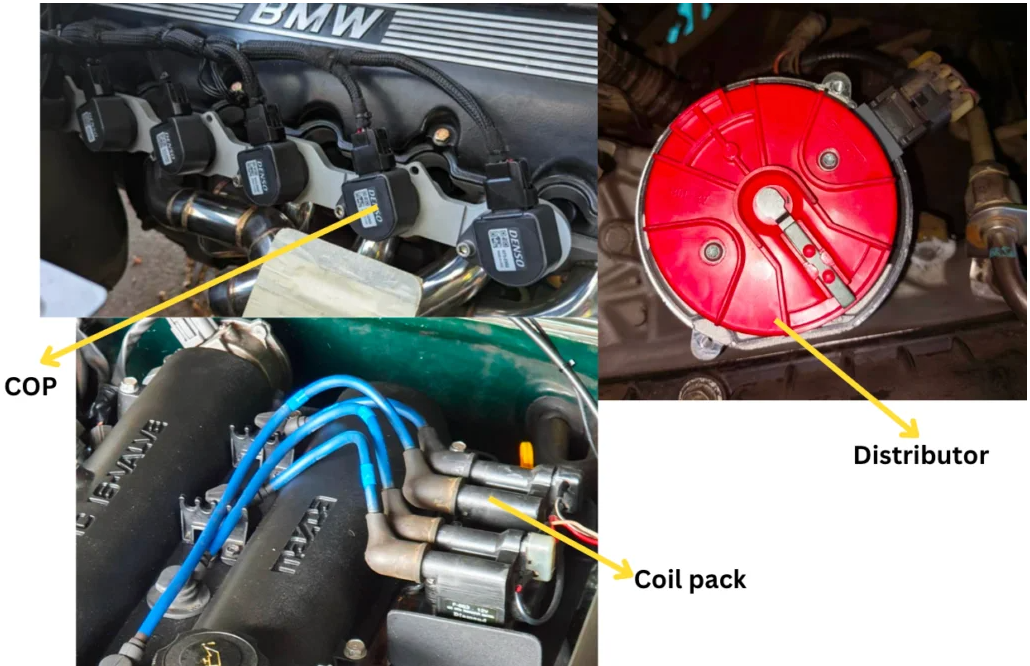
The ignition coil has two coils of wire inside it – the primary coil and the secondary coil. The primary coil connects to the battery, while the secondary coil hooks up to the spark plugs.
The terminals where the harness plugs into are for the primary coil.
When power flows through the primary coil, it makes a magnetic field that gets passed to the secondary coil. This magnetic field produces the high voltage the engine needs to light the fuel and air mix in each cylinder on fire.
If the ignition coil gets damaged, your car can stumble when you press the gas pedal at low speeds.
This happens because the busted ignition coil doesn’t put out enough voltage to ignite the fuel and air in the cylinders.
So the engine might misfire or hesitate, making the car underpowered. Other signs of a damaged ignition coil are trouble starting up, rough idling, and bad gas mileage.
Nowadays, engines use one of three kinds of ignition coils: distributor, coil pack, or COP (coil-on-plug). The type used depends on the vehicle’s make and model.
Older vehicles have a distributor-based system with a single ignition coil that generates the high voltage. This gets sent to each spark plug through a distributor cap and rotor. These two parts work together to deliver the voltage to the right spark plug at the right time.
The ignition coil links straight to the rotor, which spins inside the distributor cap. The rotor attaches to the gear drive shaft, which gets spun by the camshaft.
Under the distributor cap, a spring-loaded carbon brush touches the rotor’s metal part.
When the camshaft turns, the distributor shaft and rotor turn too. As the rotor’s outer edge passes by each internal plug terminal in the distributor cap, the spark plugs will fire in the correct order.
Coil pack ignition coils are a single unit holding multiple coils. Each one makes the high voltage for just one spark plug. Coil packs sit close to the engine and connect to the plugs through short, high-tension wires.
COP (coil-over-plug) ignition coils work kind of like coil packs. But instead of a single unit, each coil sits right on top of its spark plug. This style doesn’t need high-tension wires and makes sure the spark is super efficient.
How do ignition coils go bad?
You check the ignition coil for any physical damage. Look for cracks, corrosion, or any signs of wear and tear.
Moisture and other contaminants can also get into the ignition coil, causing corrosion. This can weaken the coil’s windings, leading to a reduction in the voltage output.
You should check also the coil’s wire and connector for signs of corrosion or damage. If the connector of the ignition coil is corroded, it can cause a poor connection, leading to a weak spark.
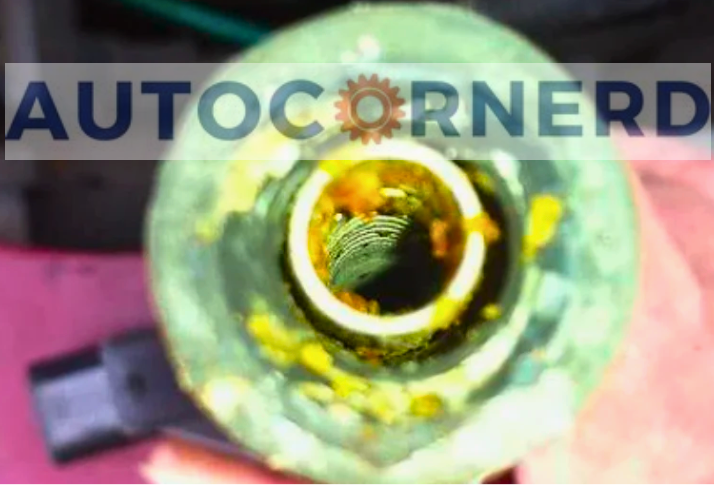
The next thing you can do is start swapping ignition coils one by one and see if car shaking goes away or not. You can watch the following YouTube video to learn more.
If your vehicle has a distributor, the contacts inside the distributor cap can become corroded or worn down, which can lead to a weak or intermittent spark.
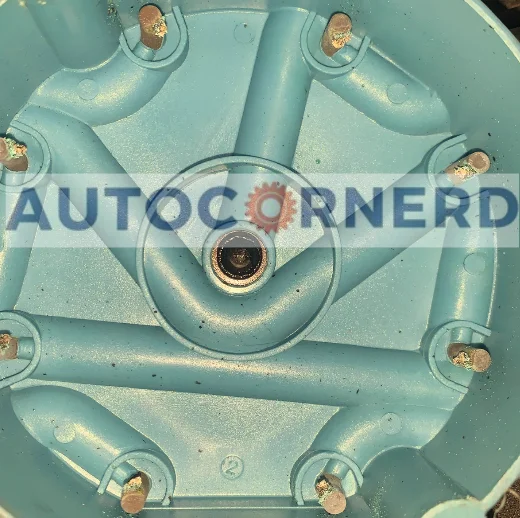
The rotor can also wear down over time, which can cause it to make poor contact with the contacts inside the distributor cap.
For the ignition coil pack, follow the below video:
The final step is to test the resistance of the ignition coil using a multimeter. Set the multimeter to the “ohms” setting and touch the probes to the coil’s terminals.
The resistance should be within the range specified by the manufacturer. If the resistance is too high or too low, it’s a sign that the ignition coil is faulty and needs to be replaced.
4. Fouled or Worn Out Spark Plugs Disrupt Combustion at Low RPM
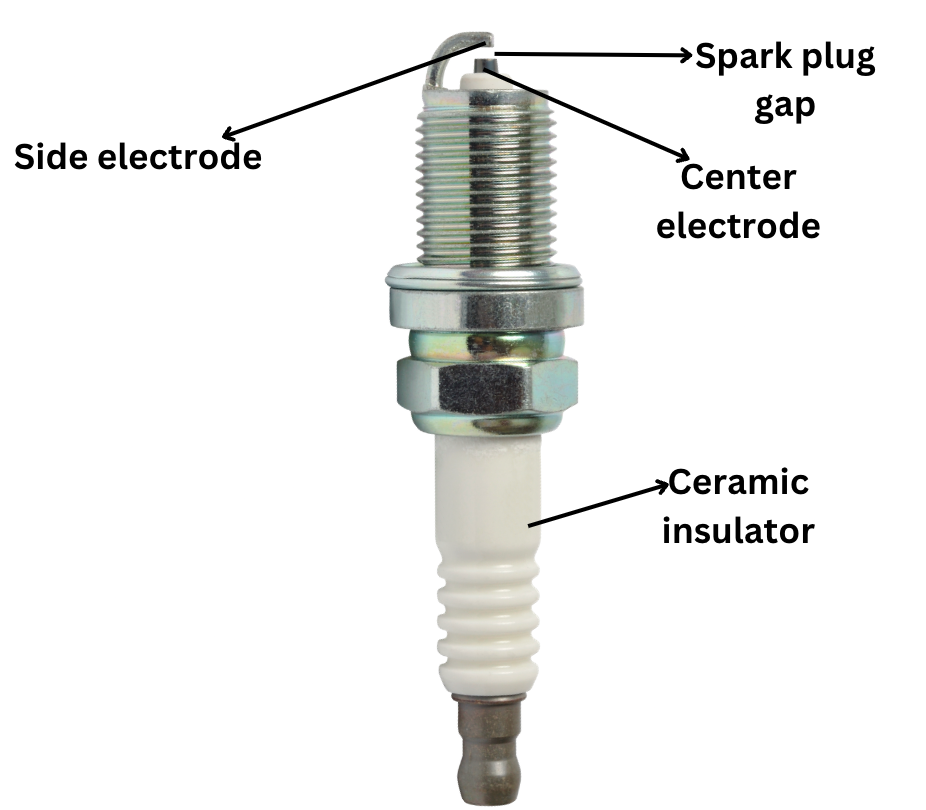
Spark plugs power a car’s engine. They make sparks to burn fuel in the engine. This makes the car move.
But spark plugs get dirty over time. Dirt on them is called fouling. Fouling stops sparks. This causes problems like car sputters and lacks power when speeding up slowly.
Why do spark plugs foul?
Different reasons cause spark plug fouling:
- Worn piston rings or seals. Oil can leak onto plugs.
- Too much fuel. Extra fuel leaves carbon on plugs. A faulty fuel pressure regulator or leaky injectors cause this.
- Wear and tear. Spark plug electrodes wear down after use. This weakens sparks. Ceramic around spark plug electrodes can crack. This wastes spark energy.
- Heat damage. High temps can melt or distort spark plug electrodes. Sparks get weaker.
- Wrong gap. Gap between spark plug electrodes should be exact. Wrong gaps mean missed sparks. The car idles rough and loses power. Use a feeler gauge to set the gap correctly.
- Blown head gasket. It causes coolant to leak and foul spark plugs.
To find out how the spark plug is fouled, you need to remove it using the spark plug socket. After that, visually inspect the spark plug to see how it was fouled.
You can take help from the spark plug trouble tracer chart (PDF download) to learn more.
How to fix?
If your vehicle has covered more than 60,000 miles, I would suggest replacing the spark plugs. Otherwise, you can try cleaning the spark plugs if they are fouled. First, use compressed air to clean off any dirt and debris. Then, keep the spark plug soaked in the brake cleaner till all the gunk on the spark plug is washed away.
5. MAF Sensor Failure May Trigger Low Power Acceleration Issues
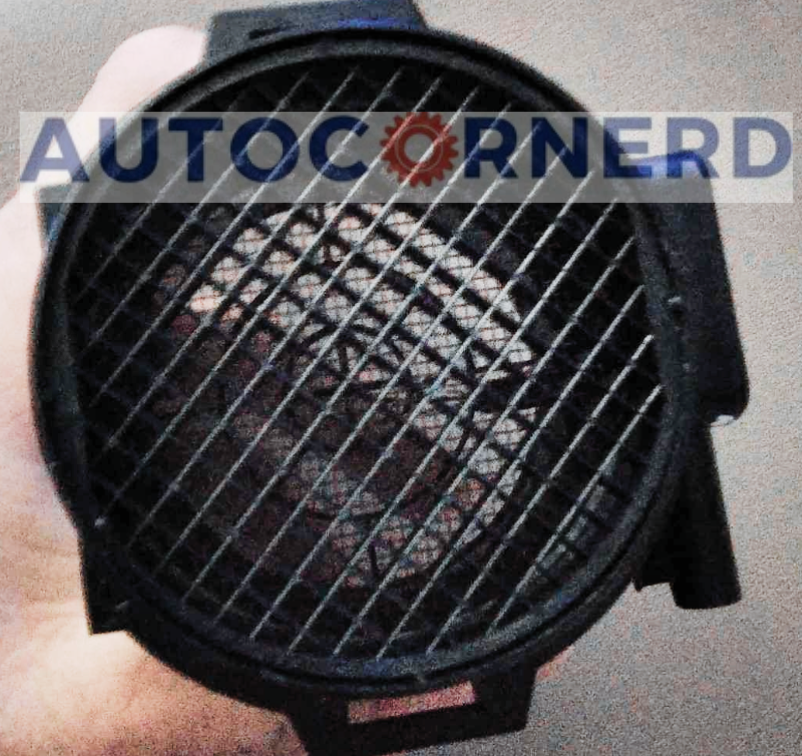
The Mass Air Flow (MAF) sensor sits in the air intake path before the throttle. It figures the air amount entering the engine. Then, it tells this to the engine computer.
The computer uses this data to find the right fuel quantity to spray into the engine. This allows full burning of the fuel-air mix.
The MAF senses air flow using a hot wire. When air passes this wire, it loses heat. As the wire cools, its electric resistance shifts. The computer reads this change to measure the air flow rate.
If the MAF fails or gets filthy, wrong readings go to the computer. So the engine hesitates.
How to test?
The MAF voltage rises as more air flows through it. If you press the gas pedal, the airflow increases. So the MAF voltage goes up.
At idle, the voltage stays under 1.0V. As engine rpm rises, the voltage may climb from 1.0V to 1.7V.
How to fix?
If the MAF sensor is dirty or covered in debris and its voltage is fluctuating, it may be possible to clean the heated element of the sensor using a specialized cleaning spray. I would recommend this cleaner. If your vehicle has a MAP sensor, it can’t be cleaned. You should replace it.
Here is a short YouTube video explaining how to clean an MAF sensor:
Some First Hand Experiences Shared By Users In Different Communities
Our team conducted research across various online communities, forums, and subreddits to gather user comments and opinions on “What Causes Engine Hesitation At Low RPM?”.
User 1 says:
Experienced jerk and shaking in my Odyssey during acceleration. It turned out to be a clogged fuel injector. A professional cleaning did the trick.
User 2 says:
My Sorento had a sputtering issue at low RPMs. Turns out the air filter was extremely dirty, restricting airflow. Replacing the air filter solved it.
User 3 says:
My Sorento had a sputtering issue at low RPMs. Turns out the air filter was extremely dirty, restricting airflow. Replacing the air filter solved it.
User 4 says:
Had a sputtering issue with my Dodge Charger. After checking the error codes, it indicated a problem with the throttle position sensor. Replaced it and the car runs fine now.
FAQs
How do I know if my fuel injector is malfunctioning and causing sputtering when accelerating?
A malfunctioning fuel injector can cause sputtering, stalling, and a decrease in fuel efficiency. You may also notice a decrease in power when accelerating or a strong smell of gasoline from the exhaust.
Can a dirty air filter cause engine hesitation when accelerating at low RPM?
Yes, a dirty air filter can restrict airflow to the engine, causing it to hesitate when accelerating. It’s essential to check and replace your air filter regularly to prevent this issue.
Is it safe to drive my car when it shakes when accelerating at low RPM?
It is not recommended to drive your car when it sputters when accelerating at low RPM because it can cause damage to your engine and increase fuel consumption. It is best to have it diagnosed and repaired as soon as possible.
